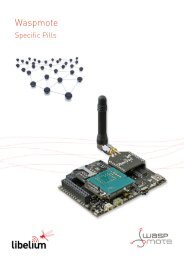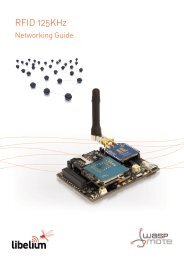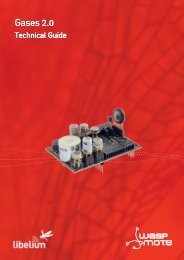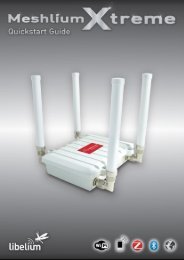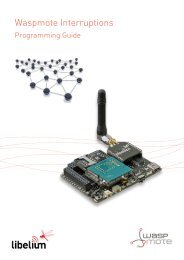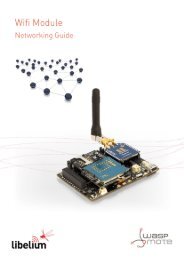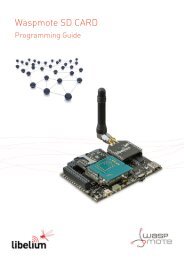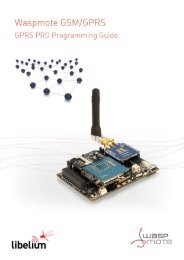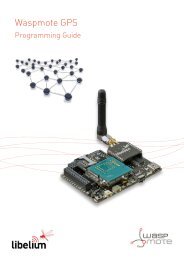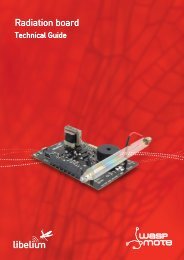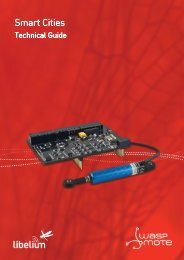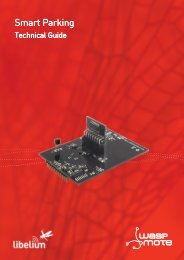Radiation board - Libelium
Radiation board - Libelium
Radiation board - Libelium
You also want an ePaper? Increase the reach of your titles
YUMPU automatically turns print PDFs into web optimized ePapers that Google loves.
Sensors4. Sensors4.1. <strong>Radiation</strong> sensor. Geiger-Müller tube J305ß4.1.1. SpecificationsManufacturer: North Optic<strong>Radiation</strong> Detection: Beta, Gamma [β, γ]Length: 111mmDiameter: 11mmRecommended Voltage: 350VPlateau Voltage: 360-440VSensitivity γ (60Co): 65cps/(µR/s)Sensitivity γ (equivalent Sievert): 108cpm / (µSv/h)Max cpm: 30000cps/mR/h: 18cpm/m/h: 1080cpm/µSv/h: 123.147092360319Factor: 0.00812037037037Figure 13: North Optic Geiger-Müller TubeWarning: Never touch Geiger-Müller tube ends directly with hands or using any metallic object under any circumstance. Tubeends works with high voltages (up to 500V) which can produce spikes if they are touched. Internal circuits of radiation <strong>board</strong> andeven the user could be seriously affected.Note: the Geiger tube should not be exposed to sunlight because the CPM may not be as accurate as indoors. We advise to use anopaque enclosure when working outdoors to cover this sensor.4.1.2. Measurement process<strong>Radiation</strong> sensor <strong>board</strong> is based on a Geiger-Müller tube, which consists of a tube filled with a low-pressure (~0.1 Atm) inert gassuch as Helium, Neon or argon (usually neon), in some cases in a penning mixture, and an organic vapor or a halogen gas. Thetube contains electrodes, between which there is a potential difference of several hundred volts, but no current flowing. Thewalls of the tube are either entirely metal or have their inside surface coated with a conductor to form the cathode while theanode is a wire passing up the center of the tube.When ionizing radiation passes through the tube, some of the gas molecules are ionized, creating positively charged ions, andelectrons. The strong electric field created by the tube’s electrodes accelerates the ions towards the cathode and the electronstowards the anode. The ion pairs gain sufficient energy to ionize further gas molecules through collisions on the way, creatingan avalanche of charged particles.This results in a short, intense pulse of current which passes (or cascades) from the negative electrode to the positive electrodeand is measured or counted.There are three types or radioactive particles, Alpha, Beta and Gamma which are generated in the nuclear power plants, Butthe Geiger-Müller tube of the Waspmote radiation <strong>board</strong> only measures Beta and Gamma particles.-17- v4.1




